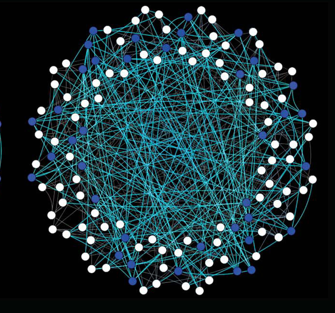 What impact has Network Theory had upon the way we implement the Decalogue Management Methodology, based on Deming and the Theory of Constraints?
What impact has Network Theory had upon the way we implement the Decalogue Management Methodology, based on Deming and the Theory of Constraints?
The Physics of Management
We were recently asked what we now do differently since the Decalogue methodology has become informed by a new area of science called Network Theory. Both Deming and Goldratt were physicists. Network theory is also a realm of physics. Physics, as opposed to engineering, has the aim of understanding how the universe works. We now know scientifically that nature is made up of networks, and this applies to organizations and economies too. To ignore this fact is to ignore a fundamental aspect of how reality works. (For this reason alone, any consideration of breaking up the European union is fraught with dangerous implications.)
Understanding Organizations As Networks
When we examine an organization in the light of network theory, we are able to unveil the network-like nature of the organization and analyze its behavior and development with a much deeper level of understanding. More importantly, we can consciously design, manage and operate the organization with a much higher level of optimization.
An organization can be viewed as a living, complex network with a precise goal. As such, it has nodes and hubs and it exhibits emergent properties. These are new structures or behaviors that emerge spontaneously from interconnection. We know that we can optimize the performance of a system by choosing a constraint and subordinating the rest of the system to the constraint. We can therefore optimize the performance of our organization by designing it as a network of projects in which certain resources are the hubs/constraints. By buffering the constraint, we are able to protect it from the accumulation of variation from the processes that feed it. In the same way, we need to protect the hub from variation, and by protecting the hub and subordinating to it, we ensure maximum performance for the entire network.
From Me to We
So what are we now aware of in our implementations thanks to Network Theory? The even greater and more urgent need for people to understand the concept so crucial in Deming, that progress can only come when people embrace a mindset of cooperation, unity and sharing, because of the interconnections and interdependencies. This is facilitated by having a constraint upon which to focus people’s efforts. As much of western culture is based on the idea of the success of the individual, trying to get people to work together towards a common goal instead of local optima when they are from different backgrounds educationally, socially and culturally, is one of our greatest challenges. People resist the idea of subordinating to the constraint, or being scheduled on a project. Guiding them through this takes enormous patience and total conviction in the value of a systemic understanding of human endeavor.
Not only does an organization need to be aware of its network properties; this new knowledge should also be shared by any Board of Directors and CEO. In this new Network paradigm, the role of the Board and of the CEO becomes that of influencers of the network. Also, those who govern the process of politics should be increasingly cognizant of the nature of networks and how to make networks sustainable. (We will discuss this further in a future post.)
Whether as consultants or temporary managers, we cannot force organizations, or the people in them, to achieve their maximum. That is a matter of free choice. Our job is to facilitate progress in the knowledge that every success is a benefit to our entire network. Ultimately, we are all interconnected.
Our books:
Sechel: Logic, Language and Tools to Manage any Organization as a System
Deming and Goldratt: The Decalogue
The Network of Projects: Driving Out Fear in the Post-Digital Age
Can We Do Away with Hierarchy?
No Fear in the Workplace – Making It Happen
Drive Out Fear by Learning to Think Systemically
Don’t Climb, Grow! Success in the Systemic Organization
Start Making Sense: Introduction To Statistical Process Control
Challenging the Mental Models of Organizations with the Core Conflict Cloud





Leave a Reply